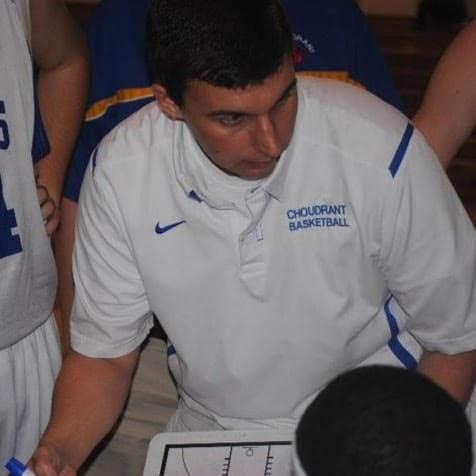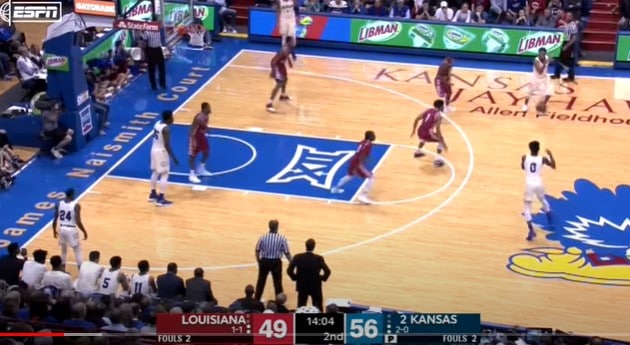Rhythm Offense and Zone Offense by Ryan Smith
Introduction
This article is going to take you through using the Rhythm Offense concepts vs a 2-3 and 1-2-2 zone defense.
Before Installing Your Rhythm Offense and Zone Offense Philosophy
Coaches need to create a preseason plan that allows plenty of time to teach players how to “play” without the players worrying about specific “system” actions. Players need to know how to make decisions for themselves within the structure of spacing, basic actions, and the “Count Method”. I would start the first practice or team meeting explaining the “Why” of the “Count Method”. This will give coaches the opportunity to show the benefits of playing within the “Count Method” on “Count Situation” catches. As a varsity or higher level head coach, I would take the time to meet with each player to discuss the “Number System” with them. Since winning is a big part of higher levels, players need to know their role and how they best fit within the overall team dynamic. It’s important at this time to talk honestly with players and encourage them their role can change throughout the preseason and season based on their improvement level. Players also need to have a general idea about what type of shots the coach expects them to take, tempo to play at, which players should take a majority of the shots, etc. I would take the time to have these team and individual meetings regardless of the system I was installing on offense.

Before putting in the “system” actions, I would want my players to be able to “play” in these areas:
- Transition
- Closeouts – Shot/Drive reads
- Shot/Pass reads for ball handler when they penetrate
- Penetration reactions by off ball players
- Passing & Catching
- Scoring/Finishing
I would use different 1v1, 2v2, and 3v3 drills (SSGs) to emphasize the actions presented in the list. During this time the coach can teach their fundamental beliefs for each point and can continue to evaluate the skill level of each player.
General Ideas – Rhythm Offense
- Basic Set Up
- Perfect Triangles
- “One Count” Actions
- “Two Count” Actions
- “Three Count” Actions
- Shallow Cuts
- Sets
- Combining the Actions
Basic Set Up – Rhythm Offense
Perfect Triangles – Rhythm Offense
I got the idea of perfect triangles from Dick Devenzio of PGC. We use the idea to help teach the proper position for our wing players.
Perimeter players forming triangles vs a 2-3 zone
Perimeter players forming triangles vs a 1-2-2 zone
“One Count” Actions
One Count actions are the same as every Count Situation.
“Two Count” Actions
On the perimeter we want our players to look to Split the Gaps in the zone as their Two Count action. We stress splitting the gaps because of the numbers advantage it creates inside the defense.
“Three Count” Actions – Rhythm Offense and Zone Offense
Benefits of waiting to Flash on Three
- Allows flasher to play from behind the defense. The defense will have already moved into their defensive positions which will make it easier for the flasher to find the hole.
We want to have a post player along the baseline playing behind the back line of the defense. We like using the term silent ninja because we want that player to sneak behind the defense and get lost behind the zone. In most cases we don’t want this player making any contact with the defense before the get the ball.
Combing the Flasher and Silent Ninja vs a 2-3 Zone – “Buddy System”
Once we get the ball inside to a post player we like for them to look for the other post player or their “Buddy”. We like to designate which player is going to be the Flasher and which one is going to be the Silent Ninja. We like to have more of an overall playmaker as the Flasher and our more traditional post player as the Silent Ninja.
Shallow Cuts – Rhythm Offense and Zone Offense
Using Dribble Ats to create shallow cuts vs the zone is something we are going to work hard at implementing this season. Here is a tweet showing an example of how to use shallow cuts vs a zone.
One way we plan on using shallow cuts is by setting ball screens up top after the cut.
Sets – Rhythm Offense and Zone Offense
Combining the Actions – Rhythm Offense and Zone Offense
Combining the Actions vs a 1-2-2 Zone
Combining the Actions vs a 2-3 Zone
Thanks and good luck this season!
Ryan Smith
Author of Rhythm Offense on Amazon
Twitter – r_b_j_c
Website – www.rhythmoffense.weebly.com
Click on the link above to download the Rhythm Offense and Zone Offense:




0 Comments